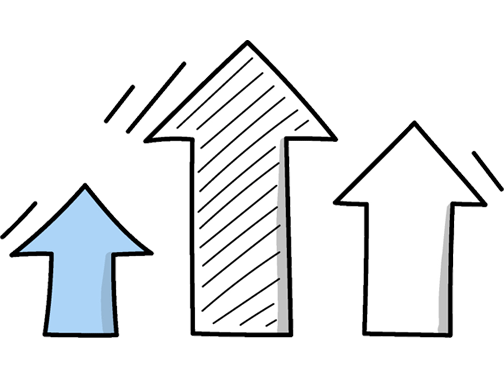Market Research Intern Interview Questions (2025 Guide)
Find out common Market Research Intern questions, how to answer, and tips for your next job interview
Practice Interviews Online - Identify your strengths and weakness in a realistic Market Research Intern mock interview, under 10 minutes
Practice Now »Market Research Intern Interview Questions
What they want to understand is how you accept and grow from feedback, as this shows your willingness to learn and improve in the role. You need to say that you listen carefully to feedback, stay positive and professional, and take concrete steps to apply it in your work.
Example: I view feedback as a chance to grow rather than just criticism. When I receive input, I take time to consider it thoughtfully and identify ways to improve. For example, during a group project, constructive comments helped me refine my data analysis skills. I try to stay positive and professional because it keeps the focus on learning and moving forward. This approach helps me develop both personally and professionally.
Hiring managers ask this question to see if you understand different data collection techniques and can choose the right one for specific research goals. In your answer, explain that you use surveys and interviews for primary data and utilize reports, articles, and databases for secondary data.
Example: When gathering primary data, I like to use surveys and interviews to get firsthand insights directly from people. For secondary data, I usually look at reports, published studies, and reliable online databases to understand existing trends. Combining both helps build a well-rounded view—like using customer feedback alongside market reports to spot opportunities or challenges in the market.
What they want to know is how you make complex information easy to understand and well-organized. You should say you outline your reports with clear headings, use simple language instead of jargon, and carefully proofread to remove unnecessary words.
Example: When writing reports, I start by mapping out the main points to create a logical flow that’s easy to follow. I focus on using straightforward language to make sure the message comes across without confusion. After drafting, I usually step away briefly, then review the report to trim any unnecessary details and sharpen the phrasing. This way, the final report is both clear and to the point, making it simple for others to understand.
Questions like this assess your ability to systematically evaluate new opportunities using data and critical thinking. You need to explain how you would gather reliable market data, analyze key factors like size and competition, and then make informed recommendations based on your findings.
Example: When analyzing a new market, I’d start by collecting reliable data to understand who the customers are and what they want. Then, I’d look at how big the market is and how quickly it’s growing, while also checking out the main competitors. Using these insights, I’d put together recommendations that help decide if entering the market makes sense and how to position ourselves effectively. For example, researching emerging trends could highlight unique opportunities.
Questions like this assess your ability to analyze data clearly and communicate insights effectively. You should say you use techniques like data visualization and summary statistics to interpret findings, and focus on presenting results in a simple, actionable way for your audience.
Example: When interpreting data, I start by identifying key patterns and trends that relate directly to the research goals. I like to use visual tools like charts and graphs to make complex information clearer and more engaging. For example, in a recent project, I turned survey results into infographics, which helped the team quickly grasp customer preferences and shape our strategy effectively. Presenting findings in a straightforward way ensures everyone can act on the insights.
What they want to understand is how you manage time and stress to meet deadlines effectively. You should say that you list and rank tasks by urgency and impact, communicate updates when priorities change, and break down complex tasks into smaller steps to stay organized and efficient.
Example: When facing several deadlines, I start by assessing which tasks will make the biggest difference and which need immediate attention. I break my work into manageable sections and stay flexible if priorities shift. Communicating openly with my team helps me stay on track and handle any unexpected challenges smoothly. For example, during a busy university project, this approach kept me focused and ensured everything was completed on time.
What they want to see is that you understand the company's position and challenges in the market, showing your ability to think strategically. You should say how you would identify unique strengths or gaps and suggest innovative ways to stand out from competitors.
Example: I believe the company can stand out by focusing on truly understanding the UK market’s unique consumer behaviours and trends. By combining thorough data analysis with creative storytelling, it can deliver insights that not only inform but inspire strategic decisions. For example, highlighting emerging local preferences or niche segments could help clients see opportunities they might otherwise miss, making the company an invaluable partner in navigating the market.
Employers ask this question to see if you understand key industry issues and can think critically about their effects. You should mention challenges like data privacy and ethical concerns, then briefly explain how these issues can lead to inaccurate data and impact client decisions.
Example: One of the biggest challenges is maintaining data quality while respecting privacy regulations, which can limit access to valuable information. This impacts the depth of insights businesses rely on. To navigate this, the industry could embrace more transparent data collection and leverage innovative tools like AI to fill gaps ethically. Adapting to shifting consumer behaviours, especially post-pandemic, also means staying agile and constantly rethinking how we gather and interpret data.
Hiring managers ask this question to see if you can adjust your communication to suit different audiences and ensure your message is clear and relevant. You should explain that you tailor your style by simplifying complex data for non-experts, considering what each stakeholder values, and actively listening to their feedback to improve understanding.
Example: I adjust how I communicate depending on who I’m speaking with, making sure to match their level of understanding and interests. For example, when talking to clients, I focus on clear, concise results, but with internal teams, I dive into the data details. I also listen carefully to feedback to ensure everyone feels heard and the message hits the mark. It’s about keeping conversations relevant and respectful to each stakeholder.
This interview question assesses your understanding of the industry and how well you’ve researched the company’s competitive landscape. You need to name relevant competitors and briefly explain how they compare to the company, showing that you’re aware of market dynamics.
Example: Certainly. In the UK market research sector, well-known competitors include firms like Kantar and Ipsos, which have a strong presence globally. Other key players are YouGov, recognized for its innovative online panels, and GfK, which specializes in consumer insights. These companies set high standards in data quality and methodology, driving the industry forward. Understanding their approaches helps in identifying opportunities for differentiation and growth.
Hiring managers ask this to see if you can communicate complex information clearly and effectively to diverse audiences. You need to explain how you simplified your findings and used relatable examples to ensure everyone understood your message.
Example: During a college project, I analysed survey data on student habits and shared the results with a group unfamiliar with statistics. I focused on using simple charts and real-life examples to explain trends, avoiding technical jargon. This approach helped everyone grasp the key insights and sparked a good discussion about potential improvements based on the findings. It taught me the importance of clarity and relatability in communicating research.
Hiring managers ask this question to assess how well you communicate, collaborate, and contribute within a team setting to achieve shared goals. In your answer, clearly describe your role in the team, how you communicated and worked with others, and what the team accomplished or learned together.
Example: During a university group project, we had to compile market data under tight deadlines. I made sure everyone was clear on their tasks by regularly checking in and sharing updates. Collaborating openly helped us spot gaps early and adjust quickly. In the end, our report was well-received, and I learned how important clear communication and mutual support are to delivering a strong team outcome.
Employers ask this question to see if you understand the evolving landscape of market research and how current trends affect business strategies. In your answer, mention key trends like the rise of AI and data analytics, give examples such as increased use of mobile surveys for better engagement, and explain how these trends help companies adapt to consumer behavior changes.
Example: Right now, the market research industry is really focused on leveraging big data and AI to gain deeper consumer insights quickly. We’re also seeing a shift towards more agile and real-time research methods, which help businesses adapt faster in a changing market. For example, companies use social media listening tools to track trends as they happen, enabling smarter, faster decisions that keep them competitive.
Employers ask this question to see how you handle complex data and extract meaningful insights. You need to explain how you cleaned and prepared the data, the analytical tools you used, and how you summarized your key findings clearly.
Example: During a university project, I worked with survey data from over 1,000 respondents. I started by checking for inconsistencies and missing entries to ensure accuracy. Using Excel and basic statistical tools, I identified key trends and patterns. I then summarized these findings in a clear report with visuals, making it easy for team members to understand and apply the insights to our marketing strategy.
Questions like this assess your practical skills and familiarity with industry-standard tools to ensure you can effectively gather and analyze data. You should mention specific software you’ve used, like Excel, SPSS, or Google Analytics, and briefly explain how you applied them in research.
Example: I’ve worked with tools like SurveyMonkey and Google Forms for collecting data, which are great for designing and distributing surveys. For analysis, I’m comfortable using Excel to organize and interpret results, as well as basic SPSS for statistical insights. I’ve also explored social media listening tools like Brandwatch to understand consumer sentiment. These have helped me gather meaningful market insights in past projects.
Employers ask this to see if you actively keep up with market changes and can interpret relevant information. You should say that you regularly follow trusted industry journals, blogs, and newsletters, and explain how you summarize key trends to understand their impact.
Example: I keep up with industry news by regularly reading trusted sources like The Guardian and Marketing Week, and I follow thought leaders on LinkedIn for fresh perspectives. When I come across new data or trends, I take time to reflect on what they mean for the market. This habit helps me stay curious and ready to adapt, which I find essential for growth in a fast-changing field like market research.
Interviewers ask this question to see if you understand the importance of data quality and your attention to detail. You need to say that you double-check data sources, use reliable tools, and validate data through cross-referencing to ensure accuracy and reliability.
Example: To ensure data accuracy and reliability, I double-check sources and cross-reference information where possible. When collecting data, I pay close attention to details and maintain clear records. For example, during a university project, I verified survey responses by comparing them against secondary data to spot inconsistencies. Being thorough and methodical helps me trust the data I’m working with and deliver meaningful insights.
Hiring managers ask this to see how you approach challenges and use problem-solving skills under pressure. You need to clearly describe the problem, the steps you took to resolve it, and the positive outcome or what you learned.
Example: During a university project, our team struggled to find reliable data on a niche market. I took the initiative to contact industry professionals for insights and combined their input with publicly available reports. This approach helped us fill gaps, allowing the project to move forward smoothly and deliver accurate analysis. It taught me the value of resourcefulness and reaching beyond traditional sources when facing a challenge.
Employers ask this question to see how you process and translate data into actionable business insights. You should explain that you methodically analyze data to find relevant patterns, connect these insights to business goals, and communicate them clearly with visual tools.
Example: When identifying key insights from market research, I start by carefully examining the data to spot meaningful trends or shifts. Then, I think about how these patterns relate to the company’s goals, ensuring the findings can support real decisions. For example, if customer feedback shows a preference for quicker delivery, that insight helps shape marketing strategies. Clear communication tailored to different teams is essential so everyone understands the impact.
Questions like this assess your ability to manage pressure and prioritize tasks effectively. You need to explain the situation briefly, highlight how you stayed organized, and emphasize the successful outcome despite the time constraint.
Example: During a university project, we had to deliver a full market analysis within three days. I organised tasks quickly, prioritised key data, and kept the team focused on clear goals. Despite the pressure, we met the deadline with a solid report. That experience taught me how to stay calm and efficient when time is tight, which I believe is essential for this role.
Interviewers ask this question to see if you can handle criticism professionally and defend your work with clear reasoning. You should say that you listen carefully to concerns, explain your research methods clearly, and respond respectfully without getting defensive.
Example: When someone questions my research, I listen carefully and stay open to new perspectives. I explain how I approached the study and the data behind my conclusions, making sure my methods are clear. If challenges reveal gaps or errors, I’m willing to revisit my work. Staying composed helps keep the conversation productive—once, a manager’s questions led me to improve my analysis, which strengthened the final report.
What they want to see is your skill in making complicated ideas easy to understand by adapting your explanation to the listener’s level and keeping them engaged. You need to describe a specific situation where you used simple language, relatable examples, or visuals to clearly communicate complex information to someone unfamiliar with the topic.
Example: During a group project, I explained detailed market analysis to teammates unfamiliar with the topic by breaking down terms into everyday language and using relatable examples. This approach helped keep everyone engaged and confident in their contributions, ensuring we all understood the data without feeling overwhelmed. It was rewarding to see how simple explanations can make complex ideas accessible and spark meaningful discussion.
This interview question helps assess your practical skills in handling and interpreting data, which is crucial for making informed market decisions. You need to explain how you would organize data using Excel functions like sorting and filtering, then apply formulas or pivot tables to identify trends and insights.
Example: When analyzing market data in Excel, I’d start by organizing the data clearly, then use pivot tables to spot trends and compare different segments. Charts would help visualize key insights like sales growth or customer preferences. Functions like VLOOKUP or filtering can quickly sift through large datasets to find relevant information, making it easier to draw meaningful conclusions that support strategic decisions.
This interview question aims to assess your practical skills with statistical tools and your ability to analyze and communicate data effectively. You should explain specific software you’ve used, describe how you applied it to real projects, and briefly mention how you interpret and present your results clearly.
Example: I’ve used tools like SPSS and Excel for analysing survey data during university projects, which helped me identify key trends and patterns. I focus on understanding what the numbers reveal about consumer behaviour and enjoy translating these insights into clear, concise reports or presentations. This approach ensures data-driven decisions are easy to grasp and useful for the team.
Interviewers ask this question to see if you understand the importance of neutrality in market research and can apply methods to avoid personal bias. You need to say you use data-driven approaches, verify sources, and cross-check results to maintain objectivity.
Example: I stay aware of my own assumptions and regularly challenge my findings by cross-checking data sources. For example, when analysing survey results, I compare different segments to spot inconsistencies or trends that might be overlooked. It’s about letting the data speak for itself and being open to conclusions that don’t fit my expectations, ensuring the insights are as clear and fair as possible.
Ace your next Market Research Intern interview with even more questions and answers
Common Interview Questions To Expect
The interviewer is looking for your motivation, passion, and understanding of the role. You can answer by discussing your skills, experience, interest in the industry, or company values.
Example: I am really excited about this role because I have a strong interest in market research and data analysis. I believe my skills in research and attention to detail make me a great fit for this position. I am eager to learn more about the industry and contribute to the team's success.
The interviewer is looking for a candidate to demonstrate their skills, experience, and passion for the role. Answers should highlight relevant qualifications, achievements, and enthusiasm for the opportunity.
Example: I believe I am the best fit for this position because of my strong analytical skills, previous experience in conducting market research, and my genuine interest in understanding consumer behavior. I have a proven track record of delivering insightful findings and recommendations that have helped drive business growth. I am excited about the opportunity to contribute to your team and learn from industry experts.
The interviewer is looking for examples of problem-solving skills, conflict resolution abilities, and how you handle challenges in a professional setting. Be honest and provide a specific situation, your actions, and the outcome.
Example: Sure! One challenge I faced at work was when I had to analyze a large set of data for a project with a tight deadline. I felt overwhelmed at first, but I broke the task down into smaller chunks, prioritized the most important data points, and worked efficiently to meet the deadline. In the end, I was able to deliver accurate and insightful analysis to my team.
The interviewer is looking for honesty, professionalism, and a valid reason for leaving your previous job. Possible answers could include seeking new challenges, career growth, relocation, or a better work-life balance.
Example: I left my last job because I was looking for new challenges and opportunities to grow in my career. I felt like I had reached a plateau in my previous role and wanted to explore different industries and gain more experience. It was a personal decision to seek out a new environment that would provide me with a better work-life balance.
The interviewer is looking for examples of your time management skills, ability to prioritize tasks, and handle pressure in a fast-paced environment. Be prepared to provide specific examples from past experiences.
Example: Yes, I am definitely able to handle multiple responsibilities at once. In my previous internship, I was responsible for conducting market research, analyzing data, and creating reports all at the same time. I prioritized tasks based on deadlines and was able to successfully manage my time to meet all requirements.
Company Research Tips
The company's website is a treasure trove of information. Look for details about the company's history, mission, vision, and values. Understand their products, services, and target audience. Check out their blog and news section for the latest updates and initiatives. This will give you a comprehensive understanding of the company's operations and culture.
Tip: Pay special attention to the 'About Us' and 'News' sections. Also, look for any recent press releases or media coverage.
Social media platforms provide valuable insights into a company's public image and customer engagement. Look at their posts, comments, likes, and shares on platforms like LinkedIn, Twitter, Facebook, and Instagram. This can give you an idea of their marketing strategies, customer feedback, and how they handle public relations.
Tip: Look for patterns in the content they post and how they engage with their audience. Also, check out any hashtags they frequently use.
Understanding the company's competitors can give you insights into the market they operate in and their unique selling propositions. Look for information on who the main competitors are, their products or services, market share, and their strengths and weaknesses. This can help you understand the company's position in the market and potential challenges.
Tip: Use tools like Google and industry reports for this research. Also, consider the company's indirect competitors.
Being aware of the latest industry trends can show that you are knowledgeable and proactive. Look for recent news, reports, and articles related to the industry. Understand the current trends, challenges, and opportunities in the market. This can help you discuss how the company can leverage these trends during your interview.
Tip: Use reliable sources like industry journals, reports, and reputable news outlets for this research. Also, consider how these trends could impact the company.
What to wear to an Market Research Intern interview
- Dark-colored business suit
- White or light-colored shirt
- Conservative tie
- Polished dress shoes
- Minimal and professional jewelry
- Neat and clean hairstyle
- Light makeup for women
- Clean, trimmed nails
- Avoid strong perfumes or colognes
- Carry a professional bag or briefcase





